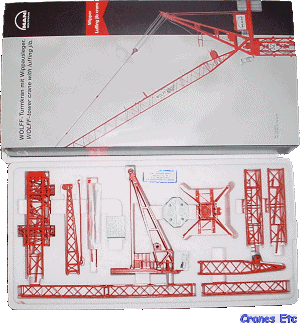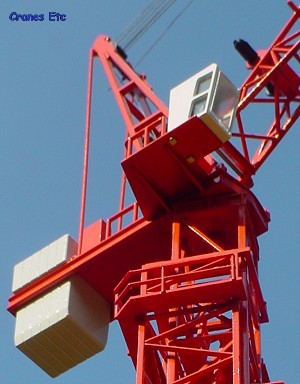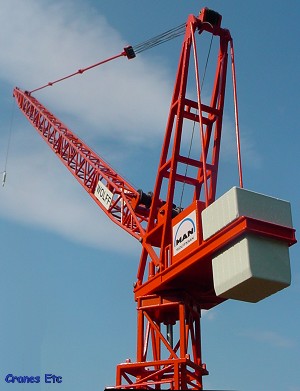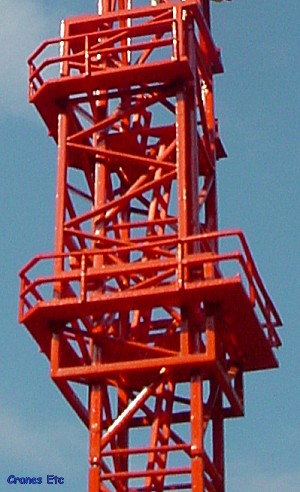 | | Model in the box. |  |  | | Counterweight is a solid block. |
| This is a model of the Wolff 180B tower crane which features a luffing jib. For a picture of the real crane click here.
Packaging
The model comes packed in a pair of expanded polystyrene trays which are held together with a cardboard picture sleeve. The review model was undamaged.
An instruction sheet is provided with the model so assembly should present no problem to the beginner.
Detail
The diecast metal of the base and mast is the same casting as used on model y and the description for that model is repeated here.
The base of the crane is a standard cross frame onto which fit two ballast weights which make the model stable. The bogies under the cross frame are plastic. The mast sections are well represented with each model section representing two real-life sections. They fit together with the usual pins which push into small holes in the mating section of mast. This works reasonably well although care needs to be exercised to join the sections in a true fashion.
The climbing frame is modelled well and can be positioned anywhere on the mast, not just at the top. Although the platforms and handrails are plastic they look the right scale and the colour match to the rest of the model is very good. The only detail lacking here is a jacking cylinder and a receiving frame to hold the new mast section during jacking.
This model is different to the trolley jib model in that it does have inserts in the mast sections representing ladders and intermediate platforms. These are made of plastic although this hardly shows.
The main crane platform has metal handrails and slewing motors, and electric equipment cabinets are modelled. The top surface is textured to represent a walkway. The driver's cab is also metal and contains a simple representation of a seat and controls.
The counterweight is a large solid metal piece which is grooved to look as though it is separate slabs of concrete which is quite effective at this scale.
Turning to the jib, it consists of separate sections which are connected together with steel pins. The lattice work is good and is a convincing representation of the real machine. The luffing gear is provided by a small metal bridle and plastic pendant bars. The moulding of the connectors at the end of the pendant bars is a little strange however as they are not in the same plane at each end with the effect that the bridle and the ropes to it are twisted and do not look quite right. A thoughtful addition on the main A-frame is a small tab to which the luffing bridle can be clipped to when the model is not erected, so that it does not have to be unstrung and later re-reeved. Pulleys on the model are tiny and are plastic. The hook is metal and far better than the oversize loaded hooks provided on some other tower crane models.
Features
The main functions of the crane can be operated. It rotates smoothly, and both jib luffing and the hoist are operated by small plastic winch handles. Because of the sectional nature of the jib it is possible to rig the crane with different length jibs, which together with use of different numbers of mast sections (three are included), means several erection configurations are available for posing the model.
Quality
The model is of good quality and is to a higher standard than many of the earlier models of this type. The paintwork is striking, and the graphics are sharp where used.
Price
The model is good value compared to some in this category.
Overall
This model is a very good looking example of a modern tower crane. The use of some of the castings from the older Wolff crane model in the mast means that this part of the model is not strictly accurate to the real thing however this is a minor criticism. Overall, at the time of its introduction, this was the best of the 1:87 scale tower crane models.
Footnotes
The model was introduced at the BAUMA exhibition in 2001 and appeared for sale that year. The model was no longer featured in the Conrad online catalogue from February 2007.
|
| |
|  | | The luffing bridle is twisted because of the way the pendant bars have been made. |  | | Climbing frame handrails are plastic as are the mast ladders. |
|

